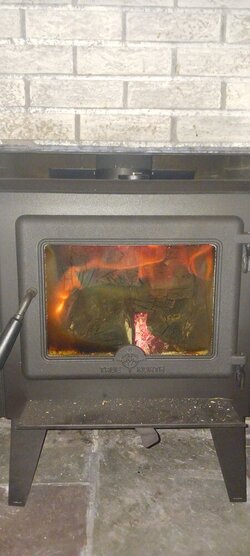Hey
I had another thread about putting a wood stove in an existing fireplace. I pulled the trigger and got a true north tn20. Very pleased with the install as we were able to remove the last layer of brick and lintel, then reinstall lintel into the next row of brick giving me the extra clearance of height for stove to easily fit in firebox.
The issue I'm have though is the stove seems to be getting too hot. I only have a thermometer on the stove top because the pipe is up the chimney and can't be seen. Thermometer is a gala fire from Amazon and says it can be installed on top, side and pipe. Thermometer is placed on front of stove top.
Today is the 2nd day of burning. All was going well until I jammed it full for a longer burn. When I reloaded I opened air control all the way up until my thermometer read about 450. Then i closed it all the way. It kept climbing to 700. This concerned me especially since the air control was closed and temp still climbing. I was supposed to leave and I didn't want to leave without it cooling down.
I researched how to cool it down and I saw a lot about opening door to get a rush of cool air in. I did this but it really didn't cool down. Hovered around 700 and then the top of the stove around the flue collar turned red. Now I have a bunch of windows and doors open with a fan blowing on it and door closes. I'm at about 600 now but hoping someone can direct me with what I'm don't wrong.
Very concerned I over fired this new stove already. Also don't undertand why the temp kept climbing with air control closed.
Any advice please?
Hoping I'm just overreacting...
Thanks!
I had another thread about putting a wood stove in an existing fireplace. I pulled the trigger and got a true north tn20. Very pleased with the install as we were able to remove the last layer of brick and lintel, then reinstall lintel into the next row of brick giving me the extra clearance of height for stove to easily fit in firebox.
The issue I'm have though is the stove seems to be getting too hot. I only have a thermometer on the stove top because the pipe is up the chimney and can't be seen. Thermometer is a gala fire from Amazon and says it can be installed on top, side and pipe. Thermometer is placed on front of stove top.
Today is the 2nd day of burning. All was going well until I jammed it full for a longer burn. When I reloaded I opened air control all the way up until my thermometer read about 450. Then i closed it all the way. It kept climbing to 700. This concerned me especially since the air control was closed and temp still climbing. I was supposed to leave and I didn't want to leave without it cooling down.
I researched how to cool it down and I saw a lot about opening door to get a rush of cool air in. I did this but it really didn't cool down. Hovered around 700 and then the top of the stove around the flue collar turned red. Now I have a bunch of windows and doors open with a fan blowing on it and door closes. I'm at about 600 now but hoping someone can direct me with what I'm don't wrong.
Very concerned I over fired this new stove already. Also don't undertand why the temp kept climbing with air control closed.
Any advice please?
Hoping I'm just overreacting...
Thanks!


